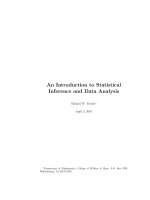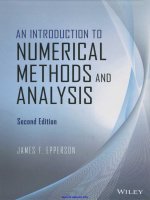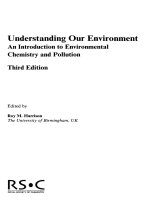Ebook An introduction to environmental chemistry and pollution (3rd edition) Part 2
Bạn đang xem bản rút gọn của tài liệu. Xem và tải ngay bản đầy đủ của tài liệu tại đây (24.17 MB, 226 trang )
CHAPTER 6
Environmental Cycling of Pollutants
ROY M. HARRISON
1
INTRODUCTION: BIOGEOCHEMICAL CYCLING
The earlier chapters of this book have followed the traditional subdivision of the environment into compartments (e.g. atmosphere, oceans,
etc.). Whilst these sub-divisions accord with human perceptions and
have certain scientific logic, they encourage the idea that each compartment is an entirely separate entity and that no exchanges occur between
them. This, of course, is far from the truth. Important exchanges of mass
and energy occur at the boundaries of the compartments and many
processes of great scientific interest and environmental importance occur
at these interfaces. A physical example is that of transfer of heat between
the ocean surfaces and the atmosphere, which has a major impact upon
climate and a great influence upon the general circulation of the atmosphere. A chemically based example is the oceanic release of dimethyl
sulfide to the atmosphere, which may, through its decomposition
products, act as a climate regulator (see Chapter 4).
Pollutants emitted into one environmental compartment will, unless
carefully controlled, enter others. Figure 1 illustrates the processes
affecting a pollutant discharged into the atmosphere.1 As mixing
processes dilute it, it may undergo chemical and physical transformations before depositing in rain or snow (wet deposition) or as dry gas or
particles (dry deposition). The deposition processes cause pollution of
land, freshwater, or the seas, according to where they occur. Similarly,
pollutants discharged into a river will, unless degraded, enter the seas.
Solid wastes are often disposed into a landfill. Nowadays these are
carefully designed to avoid leaching by rain and dissemination of
pollutants into groundwaters, which might subsequently be used for
potable supply. In the past, however, instances have come to light where
1
W. H. Schroeder and D. A. Lane, Environ. Sci. TechnoL, 1988, 22, 240.
Dry
transformations
Air
concentrations
Wet
transformations
Transport
and diffusion
Initial
mixing
Scavenging
Total emissions
Manmade
Natural
Scavenging
Dry
deposition
Wet
deposition
Figure 1 Schematic diagram of the atmospheric cycle of a pollutant1
(Reprinted from Environmental Science and Technology by permission of the
American Chemical Society)
insufficient attention was paid to the potential for groundwater contamination, and serious pollution has arisen as a result.
Another important consideration regarding pollutant cycling is that of
degradability, be it chemical or biological. Chemical elements (other
than radioisotopic forms) are, of course, non-degradable and hence once
dispersed in the environment will always be there, although they may
move between compartments. Thus, lead, for example, after emission
from industry or motor vehicles, has a rather short lifetime in the
atmosphere, but upon deposition causes pollution of vegetation, soils,
and waters.2 On a very long time-scale, lead in these compartments will
leach out from soils and transfer to the oceans, where it will concentrate
in bottom sediments.
Some chemical elements undergo chemical changes during environmental cycling which completely alter their properties. For example,
nitrate added to soil as fertilizer can be converted to gaseous nitrous
oxide by biological denitrification processes. Nitrous oxide is an unreactive gas with a long atmospheric lifetime which is destroyed only by
breakdown in the stratosphere. As will be seen later, nitrogen in the
environment may be present in a wide range of valence states, each
conferring different properties.
Some chemical compounds are degradable in the environment. For
example, methane (an important greenhouse gas) is oxidized via carbon
2
R. M. Harrison and D. P. H. Laxen, 'Lead Pollution: Causes and Control', Chapman & Hall,
London, 1981.
monoxide to carbon dioxide and water. Thus, although the chemical
elements are conserved, methane itself is destroyed and were it not
continuously replenished would disappear from the atmosphere. The
breakdown of methane is an important source of water vapour in the
stratosphere, illustrating another, perhaps less obvious, connection
between the cycles of different compounds.
Degradable chemicals which cease to be used will disappear from the
environment. PCBs are no longer used industrially to any significant
degree, having been replaced by more environmentally acceptable alternatives. Their concentrations in the environment are decreasing,
although because of their slow degradability (i.e. persistence), it will
take many years before their levels decrease below analytical detection
limits.
The transfer of an element between different environmental compartments, involving both chemical and biological processes, is termed
biogeochemical cycling. The biogeochemical cycles of the elements lead
and nitrogen will be discussed later in this chapter.
1.1
Environmental Reservoirs
To understand pollutant behaviour and biogeochemical cycling on a
global scale, it is important to appreciate the size and mixing times of the
different reservoirs. These are given in Table 1. The mixing times are a
very approximate indication of the time-scale of vertical mixing of the
reservoir.3 Global mixing can take very much longer as this involves
some very slow processes. These mixing times should be treated with
considerable caution as they oversimplify a complex system. Thus, for
example, a pollutant gas emitted at ground level mixes in the boundary
layer (ca. 1 km) on a time-scale typically of hours. Mixing into the free
troposphere (1-10 km) takes days, whilst mixing into the stratosphere
(10-50 km) is on the time-scale of several years. Thus, no one time-scale
describes atmospheric vertical mixing, and the same applies to other
reservoirs. Such concepts are useful, however, when considering the
behaviour of trace components. For example, a highly reactive hydrocarbon emitted at ground level will probably be decomposed in the
boundary layer. Sulfur dioxide, with an atmospheric lifetime of days,
may enter the free troposphere but is unlikely to enter the stratosphere.
Methane, with a lifetime of several years, extends through all of the three
regions.
3
P. Brimblecombe, 'Air Composition and Chemistry', Cambridge University Press, Cambridge, 2nd
Edn., 1996.
Table 1
Size and vertical mixing of various reservoirs
(from Brimblecombe3)
Mass
(kg)
Biosphere 3
Atmosphere
Hydrosphere
Crust
Mantle
Core
a
4.2
5.2
1.4
2.4
4.0
1.9
x 10 1 5
x 10 18
x 10 21
x 10 22
x 10 2 4
x 10 2 4
Mixing time
(years)
60
0.2
1600
> 3 x 10 7
>108
Plants, animals, and organic matter are included but coal and
sedimentary carbon are not. The mixing time of carbon in living matter
is about 50 years.
It should be noted from Table 1 that the atmosphere is a much smaller
reservoir in terms of mass than the others. The implication is that a given
pollutant mass injected into the atmosphere will represent a much larger
proportion of total mass than in other reservoirs. Because of this, and the
rather rapid mixing of the atmosphere, global pollution problems have
become serious in relation to the atmosphere before doing so in other
environmental media. The converse also tends to be true, that once
emissions into the atmosphere cease, or diminish, the beneficial impact is
seen on a relatively short time-scale. This has been seen in relation to lead,
for instance, where lead in Antarctic ice (derived from snow) has shown a
major decrease resulting from diminishing emissions from industry and
use of leaded petrol4 (Figure 2). Improved air quality in relation to CFCs
will take longer to achieve because of the much longer atmospheric
lifetimes (> 100 years) of some of these species (see Chapter 1).
1.2
Lifetimes
A very useful concept in the context of pollutant cycling is that of the
lifetime of a substance in a given reservoir. We can think in terms of
substances having sources, magnitude S, and sinks, magnitude R. At
equilibrium:
R= S
An analogy is with a bath; the inflow from a tap (S) is equal to
the outflow (R) when the bath is full. An increase in S is balanced by
an increase in R. If the total amount of substance A in the reservoir
4
J.-P. Candelone, S. Hong, C. Pellone, and C. F. Boutron,/. Geophys. Res., 1995,100,16605-16616.
Concentration of lead (pg/g)
LEAD
Date of deposition of snow or ice
Figure 2
Changes in lead concentrations in snowjice deposited in central Greenland from
1773 to 1992
(Adapted from Candelone et al.A)
(analogy = mass of water in the bath) is A9 then the lifetime, x is defined
by:
(1)
In practical terms, the lifetime is equal to the time taken for the
concentration to fall to 1/e (where e is the base of natural logarithms)
of its initial concentration, if the source is turned off. If the removal
mechanism is a chemical reaction, its rate may be described as
follows:
(2)
(In this case d[^4]/d/ describes the rate of loss of A if the source is switched
off; obviously with the source on, at equilibrium d[^4]/d/ = 0). The latter
part of equation (2) assumes first order decay kinetics, i.e. the rate of
decay is equal to the concentration of A9 termed [A], multiplied by a rate
constant, k. As discussed later this is often a reasonable approximation.
Taking equation (1) and dividing both numerator and denominator by
the volume of the reservoir, allows it to be rewritten in terms of
concentration. Thus:
(3)
since S' = R
(4)
Thus the lifetime of a constituent with a first order removal process is
equal to the inverse of the first order rate constant for its removal.
Taking an example from atmospheric chemistry, the major removal
mechanism for many trace gases is reaction with the hydroxyl radical,
OH*. Considering two substances with very different rate constants5 for
this reaction, methane and nitrogen dioxide:
(5)
molecs"1
(6)
molecs"1
(7)
Making the crude assumption of a constant concentration of OH*
radical6 (more justifiable for the long-lived methane, for which fluctuations in OH* will average out, than for short-lived nitrogen dioxide),
where
Worked example
What are the atmospheric lifetimes of CH4 and NO2 if the diurnally
averaged concentration of OH* radical is 1 x 106 molec cm~3?
Then from equation (4)
= 5.1 years for CH4
5
B. J. Finlayson-Pitts and J. N. Pitts Jr., 'Atmospheric Chemistry', John Wiley and Sons,
Chichester, 1986.
6
C . N. Hewitt and R. M. Harrison, Atmos. Environ., 1985,19, 545.
By analogy, for nitrogen dioxide, the lifetime,
T = 20 hours
This general approach to atmospheric chemical cycling has proved
useful in many instances. For example, measurements of atmospheric
concentration, [A]9 for a globally mixed component may be used to
estimate source strength, since
and
where V is the volume of atmosphere in which the component is mixed.
Source strengths estimated in this way, for example for the compound
methyl chloroform, CH3CCl3, known to destroy stratospheric ozone,
may be compared with known industrial emissions to deduce whether
natural sources contribute to the atmospheric burden.
1.2.1 Influence of Lifetime on Environmental Behaviour. Some knowledge of environmental lifetimes of chemicals is very valuable in predicting their environmental behaviour. In relation to the atmosphere, there is
an interesting relationship between the spatial variability in the concentrations of an atmospheric trace species and its atmospheric lifetime.3
Compounds such as methane and carbon dioxide with a long lifetime
with respect to removal from the atmosphere by chemical reactions or
dry and wet deposition (see Section 2 of this chapter) show little spatial
variability around the globe, as their atmospheric lifetime (several years)
exceeds the time-scale of mixing of the entire troposphere (of the order of
a year). On the other hand, for a short-lived species such as nitrogen
dioxide, removal by chemical means or dry or wet deposition occurs
much more quickly than atmospheric mixing and hence there is very
large spatial variability, with concentrations sometimes exceeding
100 ppb in urban areas, whilst remote atmosphere concentrations can
be at the level of a few ppt. By analogy, short-lived species also show a
much greater hour-to-hour and day-to-day variation in concentration at
a given measuring point than long-lived species for which local sources
impact only to a modest degree on the existing background concentration.
This illustration using the atmosphere can be taken somewhat
further in relation to other environmental media. Lifetimes of highly
soluble species such as sodium and chloride in the oceans are long
compared to the mixing times and therefore variations in salinity across
the world's oceans are relatively small (see Chapter 4). Where soils are
concerned, mixing times will generally far exceed lifetimes and extreme
local hot spot concentrations can be found where soils have become
polluted.
Lifetime also influences the way in which we study the environmental cycles of pollutants. In the case of reactive atmospheric
pollutants, it is the reaction rate, or rate of dry or wet deposition,
which determines the lifetime. We are therefore concerned mainly with
the rates of these processes in determining the atmospheric cycle. In
the case of longer-lived species, such as persistent organic compounds
like PCBs and dioxins, chemical reaction rates are rather slow and
these compounds can approach equilibrium between different environmental media such as the atmosphere and surface ocean or the
atmosphere and surface soil, with evaporation exceeding deposition
during warmer periods and wet and dry deposition replacing the
contaminant into the soils or oceans in cooler weather conditions.
Both the kinetic approach dealing with reaction rates and the thermodynamically based approach considering partition between environmental media will be introduced in this chapter. In general the kinetic
or reaction rate approach will be most appropriate to the study of
short-lived reactive substances, whilst the equilibrium approach will be
more applicable to long-lived substances.
2
2.1
RATES OF TRANSFER BETWEEN ENVIRONMENTAL
COMPARTMENTS
Air-Land Exchange
The land surface is an efficient sink for many trace gases. These are
absorbed or decomposed on contact with plants or soil surfaces. Plants
can be particularly active because of their large surface area and ability
to absorb water-soluble gases. The deposition process is crudely
described by the deposition velocity, vd,
_,
vd(cm s ]) =
Flux (figm~2 s~l)
—:——
:——
r-
Atmosphenc concentration (fig m~ J )
The term flux is analogous to a flow of material, in this case expressed as
micrograms of substance depositing per square metre of ground surface
per unit time. In the case of rough surfaces the square metre of area refers
to the area of a hypothetical horizontal flat surface beneath the true
Table 2
Some typical values of deposition velocity
Po IIu tan t
Surface
Deposition velocity
(cm s ~ l )
SO 2
SO 2
SO 2
SO 2
O3
O3
O3
HNO 3
CO
Aerosol ( < 2.5 fim)
Grass
Ocean
Soil
Forest
Dry grass
Wet grass
Snow
Grass
Soil
Grass
1.0
0.5
0.7
2.0
0.5
0.2
0.1
2.0
0.05
0.1
surface rather than the sum of the area of all the rough elements such as
plant leaves which make up the true surface.
Since the deposition process itself causes a gradient in atmospheric
concentration, vd is defined in relation to a reference height, usually
1 m, at which the atmospheric concentration is measured. For reasons
described later, vd is not a constant for a given substance, but varies
according to atmospheric and surface conditions. However, some
typical values are given in Table 2, which exemplify the massive
variability.
For some trace gases, for example, nitric acid vapour, dry deposition
represents a major sink mechanism. In this case the process may have a
major impact upon atmospheric lifetime.
Worked example
Dry deposition is frequently the main sink for ozone in the rural
atmospheric boundary layer. What is the lifetime of ozone with respect
to this process?
Assuming a typical dry deposition velocity of 1 cm s~l and a boundary layer height of 1000 m, (H),
Flux
Mixing depth (m)
where
By analogy with equation (4),
_h_
~ vd
= 1000/0.01 s
= 28 hours
Thus, taking the boundary layer as a discrete compartment, the lifetime
of ozone with respect to dry deposition is around 1 day. The lifetime in
the free troposphere (the section of the atmosphere above the boundary
layer) is longer, being controlled by transfer processes in and out, and
chemical reactions. The stratospheric lifetime of ozone is controlled by
photochemical and chemical reaction processes.
Dry deposition processes are best understood by considering a
resistance analogue. In direct analogy with electrical resistance theory,
the major resistances to deposition are represented by three resistors in
series. Considering the resistances in sequence, starting well above the
ground, these are as follows:
(i) ra, the aerodynamic resistance describes the resistance to transfer
downwards towards the surface through normally turbulent air;
(ii) rb, the boundary layer resistance describes the transfer through a
laminar boundary layer (approximately 1 mm thickness) at the
surface;
(iii) rs, the surface (or canopy) resistance is the resistance to uptake by
the surface itself. This can vary enormously, from essentially zero
for very sticky gases such as HNO 3 vapour, which attaches
irreversibly to surfaces, to very high values for gases of low
water solubility which are not utilized by plants (e.g. CFCs).
Since these resistances operate essentially in series, the total resistance, R,
which is the inverse of the deposition velocity, is equal to the sum of the
individual resistances.
(8)
Some trace gases have a net source at the ground surface and diffuse
upwards; an example is nitrous oxide.
Whether the flux is downward or upward, it is driven by a concentration gradient in the vertical, dc/dz. The relationship between flux, F, and
concentration gradient is:
where K2 is the eddy diffusivity in the vertical (a measure of the
atmospheric conductance). Fluxes, and thus deposition velocities, can
be estimated by measurement of a concentration gradient simultaneously
with the eddy diffusivity.7 It is usually assumed that trace gases transfer
in the same manner as sensible heat {i.e. convective heat transfer, not
radiative or latent heat) or momentum. Thus the eddy diffusivity for
either of these parameters is measured usually from simple meterological
variables (gradients in temperature and wind speed).
A few substances are capable of showing both upward and downward
fluxes. An example is ammonia. Ammonium in the soil, NH4+, is in
equilibrium with ammonia gas, NH3
(9)
when atmospheric concentrations of ammonia exceed equilibrium concentrations at the soil surface (known as the compensation point), the net
flux of ammonia is downwards. When atmospheric concentrations are
below the equilibrium value, ammonia is released into the air.8
2.2
Air-Sea Exchange
The oceans cover some two-thirds of the earth's surface and consequently provide a massive area for exchange of energy (climatologically
important) and matter (an important component of geochemical cycles).
The seas are a source of aerosol {i.e. small particles), which transfer to
the atmosphere. These will subsequently deposit, possibly after chemical
modification, either back in the sea (the major part) or on land (the
minor part). Marine aerosol comprises largely unfractionated seawater,
but may also contain some abnormally enriched components. One
example of abnormal enrichment occurs on the eastern coast of the
Irish Sea. Liquid effluents from the Sellafield nuclear fuel reprocessing
plant in west Cumbria are discharged into the Irish Sea by pipeline. At
one time, permitted discharges were appreciable and as a result radioisotopes such as 137Cs and several isotopes of plutonium have accumulated in the waters and sediments of the Irish Sea. A small fraction of
these radioisotopes were carried back inland in marine aerosol and
7
8
J. A. Garland, Proc. R. Soc. London, Ser. A, 1977, 354, 245.
S . Yamulki, R. M. Harrison, and K. W. T. Goulding, Atmos. Environ., 1996, 30, 109-118.
IRISH
SEA
Figure 3
Concentrations ofplutonium in soils of West Cumbria (239+24° pu to 15 cm
depth; pCi cm"2). The point marked S indicates the position of the Sellafield
reprocessing works
(From Cawse10)
deposited predominantly in the coastal zone.9 Whilst the abundance of
137
Cs in marine aerosol was reflective only of its abundance in seawater
(an enrichment factor—see Chapter 4—of close to unity), plutonium was
abnormally enriched due to selective incorporation of small suspended
sediment particles in the aerosol. This has manifested itself in enrichment
ofplutonium in soils on the west Cumbria coast,10 shown as contours of
239+ 24opu deposition (pCi cm" 2 ) to soil in Figure 3.
9
R. S. Cambray and J. D. Eakins, Nature, 1982, 300, 46.
P. A. Cawse, UKAEA Report No. AERE-9851, 1980.
10
Dry deposition velocity Vd. (cms" 1 )
Mean windspeed 10 m s"1
Mean windspeed / 5 m s"1
Diameter of unit density particle dp(jjm)
Figure 4
Calculated values of deposition velocity to water surfaces as a function of particle
size and wind speed
The seas may also act as a receptor for depositing aerosol. Deposition velocities of particles to the sea are a function of particle size,
density, and shape, as well as the state of the sea. Experimental
determination of aerosol deposition velocities to the sea is almost
impossible and we have to rely upon data derived from wind tunnel
studies and theoretical models. The results from two such models
appear in Figure 4, in which particle size is expressed as aerodynamic
diameter, or the diameter of an aerodynamically equivalent sphere of
unit specific gravity.11'12 If the airborne concentration in size fraction of
diameter dt is ch then
Total flux
where vg(dt) is the mean value of deposition velocity appropriate to the
size fraction dt. Measurements show that whilst most of the lead, for
example, is associated with small, sub-micrometre particles, the larger
particles compose the major part of the flux.
Airborne concentrations of particulate pollutants are not uniform
over the sea. The spatial distribution of zinc over the North Sea13
averaged over a number of measurement cruises appears in Figure 5.
ll
S . A . Slinn and W. G. N. Slinn, Atmos. Environ., 1980,14, 1013.
R. M. Williams, Atmos. Environ., 1982, 16, 1933.
13
C. R. Ottley and R. M. Harrison, Eurotrac ASE Annual Report, Garmisch-Partenkirchen, 1990.
12
Z n
Figure 5
Spatial distribution of zinc concentrations (in ng m
during 1989
3
) in air over the North Sea
13
(From Ottley and Harrison )
Spatial patterns of other metals and many artificial pollutants are
similar, reflecting the impact of land-based source regions, with concentrations falling toward the north and centre of the sea.
Because of its position and relatively high pollution loading, the North
Sea is a focus of considerable interest. An inventory of inputs of trace
metals {e.g. Pb, Cd, Zn, Cu, etc.) accords similar importance to riverine
inputs and atmospheric deposition.14 Controls have now been applied to
many source categories and total inputs of the metals indicated have in
general declined appreciably. One particular example is lead, for which
most European countries introduced severe controls on use in gasoline
(petrol) during the 1980s and atmospheric concentrations have fallen
accordingly. Although the data are less clear, it might be anticipated that
concentrations in river water will also decline as a result of reduced
inputs from direct atmospheric deposition and in runoff waters from
highways and land surfaces.
As explained in Chapter 4, the sea may be both a source and a sink of
trace gases. The direction of flux is dependent upon the relative
concentration in air and seawater.15 If the concentration in air is Ca, the
14
R. F. Critchley, Proc. Int. Conf. Heavy Metals in the Environment, Heidelberg, Germany; CEP
Consultants, Edinburgh, 1983, p. 1109.
15
P. S. Liss and L. Merlivat, 'The Role of Air-Sea Exchange in Geochemical Cycling', ed. P. BuatMenard, Reidel, Dordrecht, 1986, p. 113.
equilibrium concentration in seawater, CW(equ) is given by
(10)
where His the Henry's Law constant. The Henry's Law constant can be
expressed as follows:
where ps = saturation vapour pressure and S^q = equilibrium solubility
in water.
Worked example
For benzene
Calculate H for benzene at 250C.
For benzene
If Cw is the actual concentration of the dissolved gas in the surface
seawater and
the system is at equilibrium and no net transfer occurs. If, however, there
is a concentration difference, AC, where
(H)
there will be a net flux. If
the water is sub-saturated with regard to the trace gas and transfer occurs
from air to water. Conversely, gas transfers from supersaturated water to
the atmosphere if
The rate at which gas transfer occurs is expressed by
(12)
where AT(T)W is termed the total transfer velocity. This can be broken
down into component parts as follows:
(13)
where ka and &w are the individual transfer velocities for chemically
unreactive gases in air and water phases, respectively and a ( = Reactive/
^inert) is a factor which quantifies any enhancement of gas transfer in the
water due to chemical reaction. The terms rw and ra are the resistances to
transfer in the water and air phases respectively and are directly
analogous to the resistance terms in equation (8). For chemically reactive
gases, usually ra » rw and atmospheric transfer limits the overall flux.
For less reactive gases the inverse is true and ^( T ) w = A:w; the resistance in
the water is the dominant term.
Much research has gone into evaluating kw and Kmw, both in
theoretical models, and in wind tunnel and field studies. The results are
highly wind speed dependent due to the influence of wind upon the
surface state of the sea. The results of some theoretical predictions and
experimental studies16 for CO 2 (a gas for which kw is dominant) are
shown in Figure 6.
In addition to dry deposition, trace gases and particles are also
removed from the atmosphere by rainfall and other forms of precipitation (snow, hail, etc.), entering land and seas as a consequence. Wet
deposition may be simply described in two ways. Firstly,
Concentration in rain (mg kg"1)
Scavenging ratio = —
r—
:
:
:
Concentration
in air
(mg kg"1)
Typical values of scavenging ratio 17 lie within the range 300-2000.
Scavenging ratios are rather variable, dependent upon the chemical
nature of the trace substance (particle or gas, soluble or insoluble, etc.)
16
17
A. J. Watson, R. C. Upstill-Goddard, and P. S. Liss, Nature, 1991, 349, 145.
R. M. Harrison and A. G. Allen, Atmos. Environ., 1991, 25A, 1719.
(10~ 5 m s H )
Transfer velocity (cm h"1)
Beaufort
Wind speed (m s"1)
Figure 6 Air-sea transfer velocities for carbon dioxide at 200C as a function of wind speed
at 10 metres (m s~* or Beaufort Scale). The graph combines experimental data
(points) and a theoretical line
(From Watson et aL16) (Reprinted by permission from Nature (London), 349,
145; Copyright © 1991 Macmillan Magazines Ltd.)
and the type of atmospheric precipitation. Incorporation of gases and
particles into rain can occur both by in-cloud scavenging (also termed
rainout) and below-cloud scavenging (termed washout).
Numerical modellers often find it convenient to describe wet deposition by a scavenging coefficient, actually a first order rate constant for
removal from the atmosphere. Thus, for trace substance A,
where A is the washout coefficient, with units of s" 1 . A typical value of
A for a soluble substance is 10" 4 S" 1 although actual values are difficult
to measure and are highly dependent upon factors such as rainfall
intensity.
Table 3
A comparison of the concentration of major elements
in 'average' riverine paniculate material and surficial
rocks
Concentrations (g kg" l )
Element
Riverine paniculate
material
Surficial rocks
Al
Ca
Fe
K
Mg
Mn
Na
P
Si
Ti
94.0
21.5
48.0
20.0
11.8
1.1
7.1
1.2
285.0
5.6
69.3
45.0
35.9
24.4
16.4
0.7
14.2
0.6
275.0
3.8
Adapted from Martin and Meybeck18
3 TRANSFERS IN AQUATIC SYSTEMS
When rain falls over land some drains off the surface directly into surface
water courses in surface runoff. A further part of the incoming rainwater
percolates into the soil and passes more slowly into either surface waters
or underground reservoirs. Water held in rock below the surface is
termed groundwater, and a rock formation which stores and transmits
water in useful quantities is termed an aquifer. Water which passes
through soil or rock on its way to a river is chemically modified during
transit, generally by addition of soluble and colloidal substances washed
out of the ground. Some substances are removed from the water; for
example river water often contains less lead than rainwater; one
mechanism of removal is uptake by soil.
River waters carry both dissolved and suspended substances to the sea.
The concentrations and absolute fluxes vary tremendously. The suspended solids load is largely a function of the flow in the river, which
influences the degree of turbulence and thus the extent to which solids are
held in suspension and resuspended from the bed, once deposited. Table
3 shows a comparison of'average' riverine suspended particulate matter
and surficial rock composition18 for the major elements. Elements
resistant to chemical weathering or biological activity (e.g. aluminium,
titanium, iron, phosphorus) show some enrichment in the riverine solids,
18
J. M. Martin and M. Meybeck, Mar. Chem., 1979, 7, 177-206.
Table 4
A verage concentrations of the major
constituents dissolved in rain and river water
Concentrations (mg dm~ 3 )
Constituent
Rain water
River water
Na +
K+
Me 2 +
C^+
Fe
Al
CP
SO2T
HCO 3 SiO2
pH
1.98
0.30
0.27
0.09
6.3
2.3
4.1
15
0.67
0.01
7.8
11.2
58.4
13.1
3.79
0.58
0.12
5.7
Adapted from Garrels and Mackenzie19
whilst more soluble elements are subject to weathering and are depleted
in the solids, being transported largely in solution (sodium, calcium).
Some pollutant elements such as the metals lead, cadmium, and zinc tend
to be highly enriched in the solids relative to surficial rocks or soils due to
artificial inputs.
The dissolved components of river water typically exhibit significantly
higher concentrations than in rainwater19 (Table 4), due to leaching from
rocks and soils. Some insight into the processes governing river water
composition may be gained from Figure 7. Starting from the point of
lowest dissolved salts concentrations, the ratio of Na/(Na + Ca)
approaches one. This is similar to rainwater, and is termed the precipitation dominance regime. It is typified by rivers in humid tropical areas of
the world with very high rainwater inputs and little evaporation. As the
dissolved solids concentration increases the ratio Na/(Na H- Ca)
declines, indicating an increasing importance for calcium in the rock
dominance regime. Here, increased weathering of rock provides the
major source of dissolved solids. As dissolved solids increase further,
the abundance of calcium decreases relative to sodium as the water
becomes saturated with respect to CaCC>3, and this compound precipitates. Waters in the evaporation/precipitation regime are typified by
rivers in very arid parts of the world (e.g. River Jordan) and the major
seas and oceans of the world.20'21
19
R. M. Garrels and F. T. MacKenzie, 'Evolution of Sedimentary Rocks', ed. W. W. Norton, New
York, 1971.
R. J. Gibbs, Science, 1970, 170, 1088.
21
R. M. Harrison and S. J. de Mora, 'Introductory Chemistry for the Environmental Sciences',
Cambridge University Press, Cambridge, Second Edn., 1996.
20
major oceans
(a)
Black
Caspian
Jordan
Baltic
Colorado
Total dissolved solids (mg dm* 3 )
Volga
Yukon
Columbia*
Mississippi
Ganges
Congo
On
rioco
Negro
(b)
Tefe
sea
water
evaporation
crystallisation
series
rock dominance
series
precipitation
dominance
Weight Na*
Weight (Na*•Co2*)
Figure 7
The chemistry of the Earth's surface waters: (a) typical values of the ratio
Na + I(Na+ + Ca2+) as a function of dissolved solids concentration for various
major rivers and oceans; (b) the processes leading to the observed ratios
(From Gibbs20) copyright © 1970, American Association for the
Advancement of Science
The flux of material in a river to the sea is expressed by:
FluxCgs""1) = Volumetric discharge (Hi3S"1) x Concentration (gm~ 3 )
In total, the rivers of the world carry around 4.2 x 1012 kg per year of
dissolved solids to the oceans and 18.3 x 1012 kg per year of suspended
solids.
Depth ( c m )
Year deposited
background
Lead concentration
(jug g" 1 )
Figure 8 Lead profile in a lake sediment in relation to depth and the year of incorporation
(From Davies and Galloway 22 )
In slow-moving water bodies such as lakes and ocean basins, suspended solids falling to the bottom produce a well stratified layer of
bottom sediment. This is stratified in terms of age with the oldest
sediment at the bottom (where when suitably pressurized it can form
rock) and the newest at the top, in contact with the water. If burrowing
organisms do not provide too much disturbance (termed bioturbation),
the sediment can preserve a record of depositional inputs to the water
body. An example is provided by Figure 8 in which lead is analysed in a
sediment core dated from its radioisotope content.22 The concentration
rises from a background in around the year 1800, corresponding to the
onset of industrialization. Considerably increased deposition is seen after
1930 due to the introduction of leaded petrol. Whilst some of the lead
input is via surface waters, the majority probably arises from atmospheric deposition.
4
BIOGEOCHEMICAL CYCLES
A general model of a biogeochemical cycle appears in Figure 9. Although
biota are not explicitly included, their role is a very important one in
mediating transfers between the idealized compartments of the model.
For example, the role of marine phytoplankton in transferring sulfur
from the ocean to the atmosphere in the form of dimethyl sulfide has
been highlighted in Chapter 4. Biota play a major role in determining
atmospheric composition. Photosynthesis removes carbon dioxide from
22
A. O. Davies and J. N. Galloway, 'Atmospheric Pollutants in Natural Waters', ed. S. J. Eisenreich,
Ann Arbor, MI, 1981, p. 401.
atmosphere
land
freshwater
oceans
marine sediment/
rock
Figure 9
Schematic diagram of the major fluxes and compartments in a biogeochemical
cycle: (1) runoff; (2) streamflow; (3) degassing; (4) particle suspension; (5)
wet and dry deposition; (6) sedimentation; (7) remobilization
the atmosphere and replenishes oxygen. In a world without biota,
lightning would progressively convert atmospheric oxygen into nitrogen
oxides and thence to nitrate which would reside in the oceans. Biota also
exert more subtle influences. In aquatic sediments, micro-organisms
often deplete oxygen more quickly than it can be replenished from the
overlying water, producing anoxic conditions. This leads to chemical
reduction of elements such as iron and manganese, which has implications for their mobility and bioavailability.
Biological reduction processes in sediments may be viewed as the
oxidation of carbohydrate (in its simplest form CH2O) with accompanying reduction of an oxygen carrier. In the first instance, dissolved
molecular oxygen is used. The reaction is thermodynamically favoured,
as reflected by the strongly negative AG.
When all of the dissolved oxygen is consumed, anaerobic organisms take
over. Initially, nitrate-reducing bacteria are favoured
Once the nitrate is utilized, sulfate reduction takes over
Finally, methane-producing organisms dominate in a sediment depleted
in oxygen, nitrate, and sulfate
Thus highly anoxic waters are commonly sources of hydrogen sulfide,
H2S, from sulfate reduction and of methane (marsh gas). The formation
of sulfide in sediments has led to precipitation of metal sulfides over
geological time, causing accumulations of sulfide minerals of many
elements, e.g. PbS, ZnS, HgS, etc.
4.1 Case Study 1: The Biogeochemical Cycle of Nitrogen
Nitrogen has many valence states available and can exist in the environment in a number of forms, depending upon the oxidizing ability of the
environment. Figure 10 indicates the most important oxidation states
and the relative stability (in terms of free energy of formation).23 The
oxides of nitrogen represent the most oxidized and least thermodynamically stable forms. These exist only in the atmosphere. Ammonia can exist
in gaseous form in the atmosphere but rather rapidly returns to the soil
and waters as ammonium, NH41". Fixation of atmospheric N 2 by
leguminous plants leads to ammonia, NH3. In aerobic soils and aquatic
systems, NH3 and NH^ are progressively oxidized by micro-organisms
via nitrite to nitrate. The latter is taken up by some biota and used as a
nitrogen source in synthesizing amino acids and proteins, the most
thermodynamically stable form of nitrogen. After the death of the
organism, microbiological processes will convert organic nitrogen to
ammonium (ammonification) which is then available for oxidation or
use by plants. Conversion of ammonia to nitrate is termed nitrification,
whilst denitrification involves conversion of nitrate to N2.
Figure 11 shows an idealized nitrogen cycle. The numbers in boxes
represent quantities of nitrogen in the various reservoirs, whilst the
arrows show fluxes.23 It is interesting to note that substances involving
relatively small fluxes and burdens can have a major impact upon people.
Thus nitrogen oxides, NO, NO2, and N2O are very minor constituents
relative to N 2 but play major roles in photochemical air pollution (NO2),
acid rain (HNO3 from NO2), and stratospheric ozone depletion (N2O).
23
P. O'Neill, 'Environmental Chemistry', George, Allen, and Unwin, London, 1985.
Oxidation
state
Oxides of nitrogen
dinitrogen oxide
N2O
nitric oxide
NO
nitrogen dioxide
NO2
Free energy
of
formation
less stable
positive
N2
dinitrogen
N
ami
negative
NO2
nitrite
more stable
NOJ
nitrate
amino acids,
proteins
Reactions
1 fixation
2 nitrification
3 assimilation by plants
4 ammonification
5 electrification
6 nitrate-containing precipitation, often
as nitric acid in acid rain
micro-organisms play a part in reactions 1, 2 U and 5
Figure 10
Chemical forms and cycle of nitrogen
(From O'Neill23)
Nitrate from fertilizers represents a very small flux but has major
implications in terms of eutrophication of surface waters.
4.2
Case Study 2: Aspects of the Biogeochemical Cycle of Lead
Lead is a simpler case to study than nitrogen due to the small number of
available valence states. The major use of lead until recently was as
tetraalkyl lead gasoline additives in which lead is present as Pb iv . The
predominant compounds used are tetramethyl lead, Pb(CH3)4, and
tetraethyl lead, Pb(C2H5)4. These are lost to the atmosphere as vapour
from fuel evaporation and exhaust emissions from cold vehicles, but
comprise only about 1-4% of lead in polluted air.2 Leaded gasoline also
contains the scavengers 1,2-dibromoethane, CH2BrCH2Br and 1,2-
NH3/NHt
N2O/NO/NO2
N2
fertiliser
SEDIMENTSorgank
compounds
biomass
biomass
dissolved N
compounds
inorganic compounds
SEDIMENT
reservoirs
Figure 11
fluxes
Schematic representation of the biogeo chemical cycle of nitrogen, indicating
the approximate magnitude of fluxes and reservoirs
(After O'Neill23)
dichloroethane, CH2ClCH2Cl which convert lead within the engine to
lead halides, predominantly lead bromochloride, PbBrCl, in which lead
is in the Pb11 valence state, its usual form in environmental media. About
75% of lead alkyl burned in the engine is emitted as fine particles of
inorganic lead halides. Atmospheric emissions of lead arise also from
industry; both these and vehicle-emitted lead are declining. Figure 12
shows trends in United Kingdom emissions of lead to atmosphere from
leaded petrol.24 Lead emitted to the atmosphere has a lifetime of around
7-30 days and hence may be subject to long-range transport. Concentrations of trace elements in polar ice provide a historical record of
atmospheric deposition. Measurements (Figure 2) have shown a
marked enhancement in lead accompanying the increase in leaded gasoline usage, and a major decline in recent years attributable to reduced
emissions to atmosphere.4
Atmospheric lead is deposited in wet and dry deposition. Lead is
relatively immobile in soil, and agricultural surface soils in the UK
exhibit concentrations approximately double those of background soil
which contain ca. 15-20 mg kg" 1 derived from soil parent materials,
other than in areas of lead mineralization where far greater concentrations can be found. Local perturbations to the cycle of lead can be
important. For instance, the lead content of garden soils correlates
strongly with the age of the house. This is probably due to the
24
Department of Environment, Transport and the Regions, 'Digest of Environmental Statistics',
No. 19, The Stationery Office Ltd., Edinburgh, 1997.









